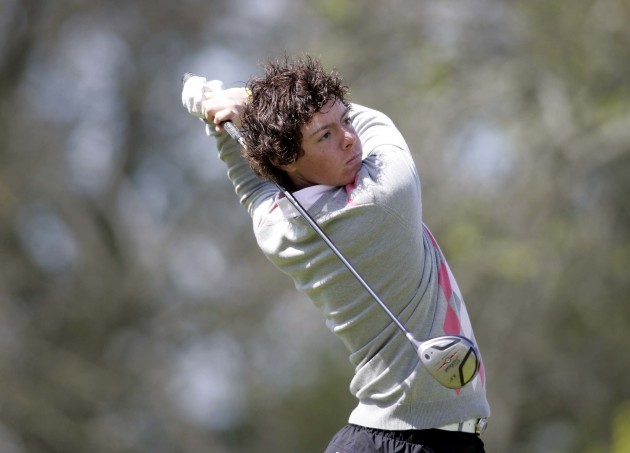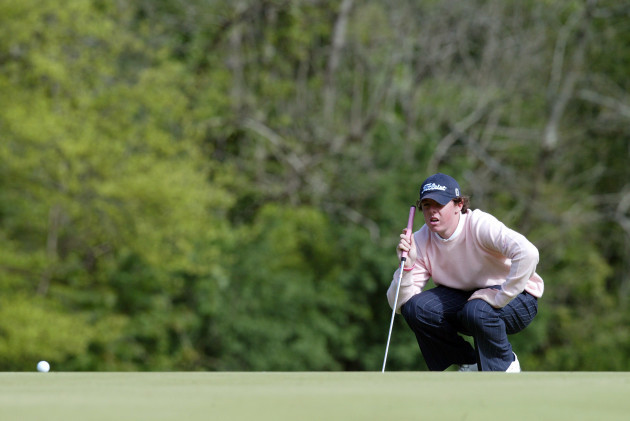SOME MOMENTS FOREVER stand alone.
For all his success, four majors now and counting; for all he has wowed, a global audience of billions; for all that he has earned, who knows how many millions; one round sets him apart.
At 16 years of age, Rory McIlroy had the golfing world alight. Already, he had sent records tumbling. Victory at the AIG Irish Close in 2005 made him the youngest winner of Ireland’s great amateur championship. That win followed shortly after he claimed the West of Ireland, likewise becoming its youngest champion.
And yet those trophies did not seem so remarkable when McIlroy pitched in with a new course record at the North of Ireland that year. On 12 July 2005, the boy wonder from Holywood, Belfast went round Royal Potrush in 61.
In Irish golfing terms, McIlroy had broken four minutes for the mile. Until that moment, such numbers had seemed impossible on a links as awed and revered as the Dunluce.
“You never thought somebody was going to shoot 61 at an amateur event, especially around Portrush,” Stephen Crowe recalls, McIlroy’s playing partner on that famous day.
Crowe, 36, played for Ulster and for Ireland (Youths) in his prime. The Dunmurry player remains a scratch man although life has curtailed his golf in recent years – married to Jill, they have two boys: Jenson and Ben. Happily for Crowe, his best years on the domestic scene coincided with McIlroy’s emergence.
“I played with Rory on a few Ulster teams,” Crowe relates. “I played for Ulster Youths (U21) at the Interprovincials in 2003. He made the team that year when he was only 14. I remember hearing the team and someone said to me: ‘Have a guess who got the last spot?’ I couldn’t get it. Eventually they told me. It was hard to believe. He was seven years younger than most of us. That was the first time that I met and played with him.”
Baby faced, curly haired – young looking even for a 16-year-old – McIlroy displayed rare gifts. Even then, he was a wonder to behold.
He took on shots that I would only have dreamt of taking on,” Crowe admits. “Nothing fazed him. He was confident, not cocky. He knew he could compete with the older guys and beat them.”
First impressions revealed a boy unfazed by what confronted him.
“He had no fear,” says Crowe. “He never backed down. He knew he had the ability to pull off the shots. If he was touch and go whether to go for a par five in two, more times than not he would go for it. He would always try to pull off the crowd pleaser. He had that instinct.”
That day when McIlroy broke new ground, 12 July 2005, began without an inkling for his playing partners. They played the Valley Course the previous day. Stroke play qualifying at the North of Ireland, one round on each layout at Royal Portrush, served to reduce the field to 64 for match play. Heroics were not required.
“You never thought somebody was going to shoot 61 at an amateur event, especially around Portrush,” Crowe states. “You might have thought he’d go out and shoot mid 60s.”
On the lesser, less taxing course, McIlroy opened with a modest 71. He began round two middle of the pack.
“He was two under after eight,” Crowe recalls. “It was a good score but you don’t think he’s going to do what he did.”
McIlroy opened with a regulation par and birdied the second, two putting the par five. He picked up another shot at the sixth, the picturesque par three by the shore named Harry Colt’s in honour of the course architect. Impressive golf but not yet world record pace.
At the turn, everything changed: “He birdied nine, eagled 10 and birdied 11. It was like an explosion. From nowhere he was six under. Then you start to think this might be a special round.”
McIlroy settled for mere pars on 12 and 13. The 14th, Calamity Corner, presents as daunting as its name suggests. The green is perched atop grand dune and the drop appears like golf’s great canyon to the right. Miss and your ball is dead.
Crowe still pictures the tee shot: “He hit a big high draw out over the valley into the middle of the green. It was one of those shots you wish you could hit yourself.”
A birdie moved McIlroy to seven under. On he went, in that fashion, to the finish.
I think, when the crowd got bigger, he started to play better,” Crowe asserts. “He birdied the last five holes.”
On 17, the last par five, the swell in numbers led to practical problems.
“I couldn’t hit my shot,” states Crowe. “I had to say to people: ‘Excuse me, do you mind moving back?’ It wasn’t getting out of control but it would have been no harm to have a marshal there.”
McIlroy looked at ease. His playing partner sensed as much: “He would have been hitting driver off a lot of tees when you would have been hitting irons or three wood. I wouldn’t have had the same mindset.”
The tee shot at 16 framed the McIlroy mentality. Kenny Fahey, who came through stroke play qualifying with four shots to spare, still quivers to think about that drive.
“The 16th was terrifying,” Fahey avows.
The tee shot down 16 is on your mind all season before the event. You could be there all day losing golf balls. The fairway used to bottleneck down at the bottom right corner into a pathway up to the green.”
Fahey played for Ireland at Boys level from 2000 to 2001 and was home following his final year at the University of Rhode Island. Talk about the boy wonder from Belfast reached America during his time there.
“When I was in the States, I had heard about him,” Fahey notes. “Every coach has a player that they think is going to be the real deal but once in a lifetime comes a player who is the real deal.”
McIlroy’s play that day stays in his mind: “At eight under par, he takes out driver on 16 and nobody else hit driver down 16 that day unless he couldn’t hit it 230 yards.
It was an incredible shot at eight under par. I don’t think I’d hit driver down there at 9pm on my own with a shag bag.”
McIlroy finished with another birdie to complete the record-breaking round. A customary handshake concluded matters but momentous as it was, Stephen Crowe cannot attest what he said in that moment. He suspects their exchange went along a facetious line: “Ya little bugger. How did you do that?”
Like his Ulster teammates, McIlroy enjoyed the joking and the joshing.
“We always had a bit of craic,” emphasises Crowe. “He was down to earth. He would always stop and speak to you. He never got too big for his boots.”
Crowe last played the North of Ireland in 2013 but he will see Royal Portrush up close again this week when he travels to The Open. The crowds will flock around McIlroy, naturally, but Crowe was there when the genie first appeared.
“It’s nice to say I was there and I was playing with him,” Crowe reflects. “I’m sure he would have shot that score playing with whoever else. It’s always something I can talk about. Unless someone shoots 59 around it, I don’t think it’s ever going to be beaten, hopefully not next week.”
History suggests Crowe need not worry. Anyway, that game he played with McIlroy is something others can only ever wish.
The42 is on Instagram! Tap the button below on your phone to follow us!



